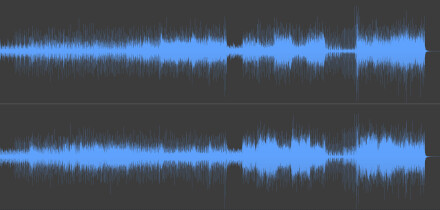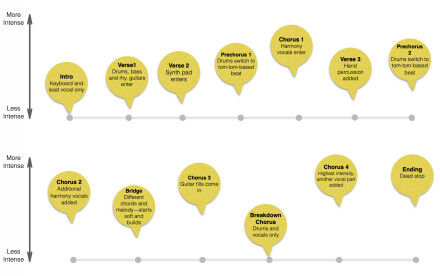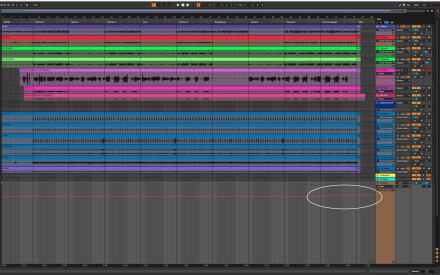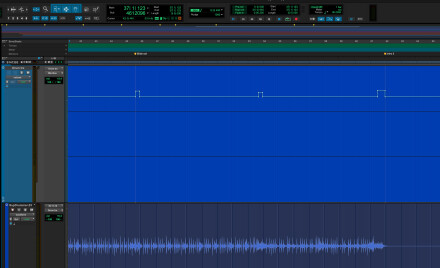Songwriting and performance are crucial ingredients for producing a great song. Another is the arrangement. That is, deciding which instrument and vocal parts will be in a song, and where they'll come in. Even a well-written song needs a compelling arrangement to make it into a great recording.

Keep it Moving
In order to maintain a listener’s attention, a song arrangement needs to be dynamic. No, I’m not talking about dynamics processing, which involves compressing and limiting audio. Nor am I talking about dynamic range, an audio measurement of the difference between the loudest and softest parts of a music file. What I’m focusing on here is how to strategically arrange the energy, intensity and even the harmonic structure of a song as it goes from start to finish to create maximum impact on the listener.
The screenshot below shows the waveform display of a complete song. It was arranged to feature dynamic changes with a build to the highest level at the end, 
One of the big mistakes that many novice musical artists and producers make is to pay too little attention to dynamics in an arrangement. That can result in a tedious recording of an otherwise good song. You can use some of the tips I give here during pre-production, some during the tracking process and some during the mix.
Build the Drama
The key to making the arrangement more dynamic is to introduce change along the way. Some of the key variables include which instruments and vocal parts come in where, the order and structure of the song sections, the harmonic structure (chord progressions) how energetic the parts are, the variations in level of the various parts, and the types of sounds captured in the recording or manipulated in the mix.
You want to give the song a dramatic arc. In most pop songs, you want the most intense and powerful part of the arrangement towards the end. Think of it like a movie that reaches its peak in excitement near the end.
That doesn’t necessarily mean you want to build the intensity in a linear fashion, however. A lot of times, the dynamics of the song will go up and down. But by the time it gets near the end, it’s usually at its peak level of intensity.
Use Song Structure
A well-written song will already have some dynamic contrast built-in by virtue of its structure. Usually, a chorus will have more energy than a verse. So when a song goes from verse to chorus, there’s typically an increase in intensity. Many songs have pre-choruses, which are song sections that build the energy going into a chorus setting it up for maximum impact.
Many songs have a bridge, which typically comes in after a couple of verses and choruses. The purpose of a bridge is to provide a change of pace. It might have a different beat, go to a completely different chord progression etc. If your bridge is too similar to a chorus, it won’t fulfill its purpose.
An instrumental break is another change-of-pace element you can use in an arrangement. Just the act of the lead vocal going out and a lead instrument coming in provides contrast. In addition, there’s usually a dynamic change. The whole band typically picks up its energy during a solo section. Alternatively, you can have a solo that starts quietly and builds to a peak before you go into the next verse or chorus. You might even have a solo section in a different key and then modulates back to the original key at the end.
Or you could even put in a modulation somewhere late in an arrangement. Usually, you’d put one in at the point where a chorus repeats. You have to be careful with such modulations because they can sound dated and clichéd. Use them as a last resort if you’ve got no other way to make the repeat section more interesting. In many musical styles, you rarely, if ever, hear modulations.
Add and Subtract Elements
Another way to create dynamics in a song through the arrangement is by adding and subtracting parts. Unlike a live arrangement, where all or most instruments are typically in from the start, studio arrangements often have dynamic variations caused by instruments coming in and out.
If you listen carefully to pop songs, you’ll notice that one of the ways their arrangements create interest as they go is by adding elements in successive song sections. For instance, you might add a percussion part or a keyboard pad when you get to the second verse or second chorus to differentiate it from the first one and to build the intensity a little bit.
Another way to go is to add additional background vocal parts when the song gets to the second or third chorus, prechorus, or even the second verse. Adding instruments and vocal parts is more subtle than contrasting different song sections, like verses and choruses, but they help keep the listener’s interest. Even with excellent lyrics, listeners are more likely to get bored by repeated song sections that sound identical other than the words changing.
The most extreme version of dynamic contrast through subtracting elements is a breakdown, where most instruments drop out, but the vocals stay in. You’ll usually hear a breakdown in the latter part of the song, and they are often bookended by choruses. A breakdown can be just drums and vocals, or just drums or may have some other instruments that remain in.
Even if you didn’t include a breakdown when you recorded the song, you could create one when you’re mixing by muting instruments temporarily. Not only do you get the sizeable dynamic drop when the breakdown starts, but you get a substantial dynamic increase when the instruments come back in.
Intros are another excellent area for contrast. If you listen to pop songs, many will start with minimal instrumentation, such as vocal and one chordal instrument like piano, synth or guitar. Often, the bass and drums won’t come in until the middle of the intro or the beginning of the first verse. Or, sometimes, the drums will play a less intense part at the beginning of the song, such as one that uses a sidestick instead of a snare and doesn’t go into full gear until the chorus. Another way to create a breakdown-like effect is to return to the intro later in the song.
The illustration below shows maps the intensity of a hypothetical song, showing how it builds, then drops low for a breakdown and comes back to its highest intensity at the last chorus and ending.
Create Excitement with Automation
Assuming that the instrument parts in a song are real instruments rather than just MIDI-programmed ones, it’s best to make sure the players know in which parts of the song they need to play a little louder or quieter. You can add dynamic markings if you’re using written music. But in most pop or rock recordings, the musicians usually mostly play the song without written music other than possibly a chord chart. As a result, you can sometimes get to the mixing stage and realize that the tracks aren’t as dynamically varied as you would have liked.
One solution is to use changes in volume automation to raise the level of particular tracks (or even the entire mix) subtly when you need an increase in energy. You have to do it subtly, going up or down by one or two dB. If you were to write in a more significant change, it probably wouldn’t sound realistic.
The highlighted section below shows the master volume automation subtly raised near the end of the song to add more dynamic strength.
A related trick is to add energy by turning up the drum fills either throughout the song or as you get toward the end. Again, be subtle. Don’t add more than about 3dB. You want it to sound like the drummer is just “digging in” a little on the fills. You’d be surprised how that can energize a drum part.
The screenshot below shows how you can push up drum fills using volume automation to energize the drum track.
Another technique is to use different reverb and delay treatments in different song sections. You could have a delay that kicks in on the choruses or a reverb that changes subtly from verse to prechorus to chorus.
You can also subtly change the instrument sounds. For example, put a little more distortion on the rhythm guitar in the choruses. Or maybe add a filtering effect to the synth during the bridge to differentiate it from how it sounds in the rest of the recording.
Take Note
Whenever you’re producing a song, it’s imperative to be mindful of the impact of the song arrangement on the final product. As I’ve discussed in this article, you have a lot of tools available to make your arrangements as dynamic and exciting as possible. Don’t be afraid to use them.
A good exercise is to listen to some of your favorite songs and analyze how they evolve over time. Notice which elements are in at the beginning and the other parts that come in or drop out, and the dynamic changes. You may be pretty surprised at how the arrangement develops along the way.



